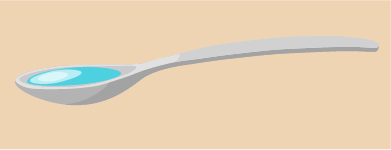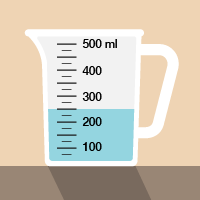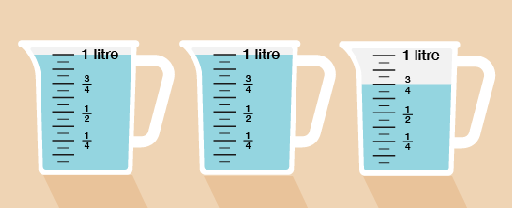4.1 Instruments of measure
To measure a very small amount, you might use a teaspoon. This is the same as 5 millilitres (ml).
To measure larger amounts, you would probably use a measuring jug of some kind. Measuring jugs are often labelled in millilitres, especially newer ones, and they can come in different sizes: some can measure up to 500 ml of liquid and others up to 1 litre (1 000 ml). Some may hold more or less than this.
Now take a look at the following example.
Example: Measuring liquids
If you had to measure out 350 ml of juice for a recipe, where would the liquid come to in this jug?
Method
There are three marks on the jug between 300 ml and 400 ml. These mark 325, 350 and 375 ml. So you need to fill the jug to the middle mark (remember to look for the level where the liquid touches the scale). You may have to hold a jug up to eye level to measure the amount as accurately as you can.
Now try the following activity. Remember to check your answers once you have completed the questions.
Activity 15: Looking at capacity (volume)
Now that you have seen the example, have a go at the following activity;
- How much coffee or tea does a cup you usually drink out of hold? Estimate the volume first, and write down your estimate. Next, fill your cup with water and then pour the water into a measuring jug. (Hint: A standard bottle of water holds 500 ml. A can of of pop is 330 ml.)
- A scientist has to measure 2.8 ml of liquid in this syringe. Where should the liquid come to?
- A plumber has drained water from a faulty central heating system into a set of measuring jugs. How many litres in total has the plumber drained from the system? Notice how on these measuring jugs, the scale is marked up in fractions of a litre rather than in millilitres.
Answer
- I estimated that my cup holds 400 ml. It actually holds 350 ml. Your answer may be quite different to this, depending on the size of the cup.
- The divisions are marked every 0.1 ml. The syringe should look like this:
- The plumber has drained two full one-litre jugs and three-quarters of another jug, making 2.75 litres in total. This could also be written as 2 750 ml or 2 litres 750 ml.







